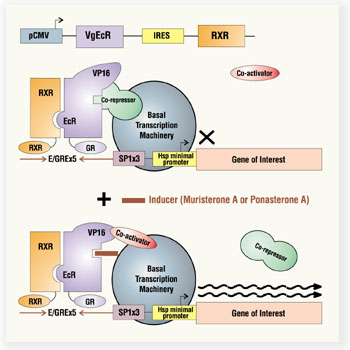Complete Control Inducible Mammalian Expression System
誘導型哺乳動物蛋白表現系統
The Complete Control Inducible Mammalian Expression System is designed to provide the tightest control of expression available in mammalian cells. The system is based on a synthetic ecdysone-inducible receptor and a synthetic receptor recognition element that modulates expression of your gene of interest.
特色
Control Transcription
Ths system is based on a synthetic ecdysone-inducible receptor and a synthetic receptor recognition element that modulates experssion of your gene of interest (see Figure 1). The artificial nature of the receptor and the recognition element ensures that endogenous host transcription factors and genes will not be activated, resulting in extremely low background. In addtion, the receptors are bound to the recognition element in the absence of inducer, further reducing background expresion. Ponasterone A causes a conformational chagne of the receptor subunits, which removes the repressors and recruits transcriptional machinery.
Powerful Induction
Induction is fast and potent, in just 20 hours we have observed as high as 1,747-fold induction in transient assays and 1,030-fold induction in a double-stable cell line. Using a range of ponasterone A gives a linear dose response curve, allowing the amount of induction to be easily moderated.
Innovative Vectors
Two vectors are used to control expression in the Complete Control system. The synthetic receptor is constitutively expressed as a heterodimer consisting of the ecdysone receptor (EcR) and the retinoid-X-receptor (RXR). Both subunits of the receptor are produced from the pERV3 vector, using an internal ribosomal re-entry site (IRES) to allow expression of both proteins from the same CMV promoter. This unique design allows expression of the heterodimer receptor in a wide variety of cell lines. The expression vector, pEGSH, is designed for easy detection of expressed protein by either RNase protection assay using T3 antisense probes or by western analysis using the FLAG epitope. (Figure 1)
 Figure 1: The Ecdysone-Inducible Expression System The Nuclear receptor proteins RXR and VgEcR are coexpressed from the CMV promoter VgEcR: hybrid nuclear receptor comprised of the ecdysone receptor (EcR) ligand-binding and dimerization domains, the VP16 transcriptional activation domain and the glucocorticoid receptor (GR) DNA binding domain. The heterodimeric ecdysone receptor remains bound to five copies of the E/GRE recognition element located upstream of a minimal promoter in the inducible expression cassete. The inductible promoter remains transcriptionally silent until induction with the ecdysone analogs muristerone A or ponasterone A. Interaction between the inducer and the EcR ligand-binding domain results in the recruitment of coacivator(s) and, thus, transcriptional activation that can reach over three orders of magnitude.
Figure 1: The Ecdysone-Inducible Expression System The Nuclear receptor proteins RXR and VgEcR are coexpressed from the CMV promoter VgEcR: hybrid nuclear receptor comprised of the ecdysone receptor (EcR) ligand-binding and dimerization domains, the VP16 transcriptional activation domain and the glucocorticoid receptor (GR) DNA binding domain. The heterodimeric ecdysone receptor remains bound to five copies of the E/GRE recognition element located upstream of a minimal promoter in the inducible expression cassete. The inductible promoter remains transcriptionally silent until induction with the ecdysone analogs muristerone A or ponasterone A. Interaction between the inducer and the EcR ligand-binding domain results in the recruitment of coacivator(s) and, thus, transcriptional activation that can reach over three orders of magnitude.Retroviral Version
We have developed a retroviral version of the Complete Control Inducible Mammalian Expression System to expand its utility. Gene delivery using retroviruses often yields transduction efficiencies close to 100%, and the proviral copy number can be easily controlled by varying the multiplicity of infection (MOI). This latter feature is particularly important for inducible systems, for which low basal expression and high induction ratios are affected by copy number. Thus, transduction of the target cell with virus at an optimal MOI should yield a high frequency of clones capable of mediating desirable expression profiles without exhaustive colony screening. The two retroviral vectors are pFB-ERV, an MMLV-based replication-defective retroviral vector that delivers the ecdysone receptor proteins RXR and VgEcR, and the pCFB-EGSH retroviral vector containing the inducible cassette. Used together, we have attained induction ratios of >1,000-fold in tissue culture cells.
Save Time with Stable Cell Lines
The best method to create double-stable cell lines is sequentially, first establishing pERV3 stable cell lines and selecting the line that gives the highest induction and the lowest backgrounds using the pEGSH-luc control vector in transient assays. Then, use this line to create a double-stable cell line using the pEGSH expression construct containing your gene of interest. Strategene has eliminated the first step of this process with a collection of pERV3 stable cell lines, derived from CHO, NIH3T3 and 293 cells. Each cell line is tested for viability and functionally tested in a transient assay using the pEGSH-luc control vector and monitoring luciferase expression after induction with ponasterone-A.
產品列表
| 貨號 | 產品 | 數量 | |
|---|---|---|---|
| 240028 | pCFB-EGSH Retroviral Vector pCFB-EGSH 反轉錄病毒載體(組) 廠牌:Agilent | 10 µg | |
| 217460 | pERV3 Vector pERV3 載體(組) 廠牌:Agilent | 100 µg | |
| 217461 | pEGSH Vector pEGSH 載體(組) 廠牌:Agilent | 20 µg | |
| 217467 | Ponasterone A 松甾酮A 載體(組) 廠牌:Agilent | 1 mg | |
| 217468 | Complete Control Vector Kit 完整控制載體套組(組) 廠牌:Agilent | 1 Kit | |
| 217564 | pFB-ERV Vector pFB-ERV 載體(組) 廠牌:Agilent | 10 µg |
Complete Control Inducible Mammalian Expression System
- Dose-responsive inducible mammalian expression
- Induction as high as 1,700 fold
- Novel IRES site allows expression of both receptor subunits from the same CMV promoter
- Retroviral and plasmid gene delivery systems available
回到頂端


